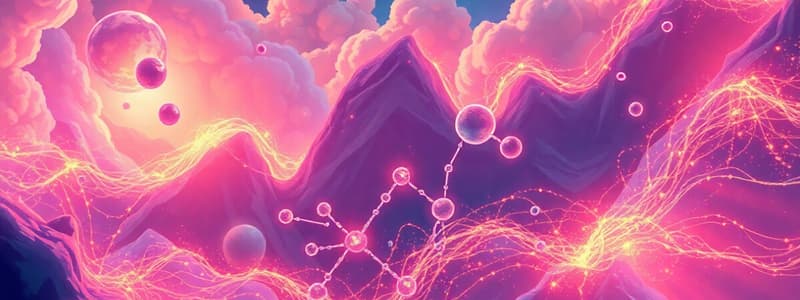Podcast
Questions and Answers
What does the term 'activation energy' refer to in a chemical reaction?
What does the term 'activation energy' refer to in a chemical reaction?
- Energy barrier that must be overcome for a reaction to occur (correct)
- Energy required to break bonds
- Energy required to form products
- Energy released during exothermic reactions
For a pseudo first-order reaction, what is implied about the concentration of one reactant?
For a pseudo first-order reaction, what is implied about the concentration of one reactant?
- It changes significantly throughout the reaction
- It is not involved in the rate law
- It remains constant during the reaction (correct)
- It must be zero for the reaction to occur
In a zero-order reaction, how is the rate of reaction dependent on the concentration of reactants?
In a zero-order reaction, how is the rate of reaction dependent on the concentration of reactants?
- It is directly proportional to concentration
- It is independent of concentration (correct)
- It decreases exponentially with concentration
- It doubles with each increment in concentration
When is the rate law of a reaction derived?
When is the rate law of a reaction derived?
What does the rate constant (k) indicate in a reaction's rate law?
What does the rate constant (k) indicate in a reaction's rate law?
What does the variable 'k' represent in the equation for the rate of the reaction?
What does the variable 'k' represent in the equation for the rate of the reaction?
Under what condition can a reaction behave as a first-order reaction despite not truly being one?
Under what condition can a reaction behave as a first-order reaction despite not truly being one?
What is the half-life of a reactant?
What is the half-life of a reactant?
In the equation for the rate of reaction, which concentrations are multiplied together?
In the equation for the rate of reaction, which concentrations are multiplied together?
Which of the following reactions is mentioned as behaving in a certain manner under specified conditions?
Which of the following reactions is mentioned as behaving in a certain manner under specified conditions?
What does molarity measure?
What does molarity measure?
Which of the following describes normality?
Which of the following describes normality?
How is mole fraction calculated?
How is mole fraction calculated?
Which unit is commonly used for expressing mass by volume percentage (w/v)?
Which unit is commonly used for expressing mass by volume percentage (w/v)?
What does parts per million (ppm) typically represent?
What does parts per million (ppm) typically represent?
What is the formula used to calculate mass percentage (w/w)?
What is the formula used to calculate mass percentage (w/w)?
Which of the following statements is true about normality?
Which of the following statements is true about normality?
What is the primary purpose of using mind maps?
What is the primary purpose of using mind maps?
In mind mapping, which level of association is represented by the thickest line?
In mind mapping, which level of association is represented by the thickest line?
How do associations in mind maps contribute to memory strength?
How do associations in mind maps contribute to memory strength?
Which of the following crystal systems has the parameters a = b = c and angles $\alpha = \beta = \gamma = 90°$?
Which of the following crystal systems has the parameters a = b = c and angles $\alpha = \beta = \gamma = 90°$?
What defines the Tetragonal crystal system?
What defines the Tetragonal crystal system?
Which crystal system is characterized by having angles $\alpha = \beta = 90°$ and $\gamma > 90°$?
Which crystal system is characterized by having angles $\alpha = \beta = 90°$ and $\gamma > 90°$?
Which of the following is not a type of crystal system mentioned?
Which of the following is not a type of crystal system mentioned?
What is the characteristic of the Rhombohedral crystal system?
What is the characteristic of the Rhombohedral crystal system?
What differentiates the Hexagonal system in terms of axes?
What differentiates the Hexagonal system in terms of axes?
Which intermolecular force is relevant for materials held by dipole-dipole interactions?
Which intermolecular force is relevant for materials held by dipole-dipole interactions?
Which crystal system is described as having a base-centered structure?
Which crystal system is described as having a base-centered structure?
What kind of forces hold atoms or molecules in gases?
What kind of forces hold atoms or molecules in gases?
How are molecules held in a covalent bond?
How are molecules held in a covalent bond?
What characterizes a cubic crystal structure compared to others?
What characterizes a cubic crystal structure compared to others?
What is the relationship between temperature and osmotic pressure?
What is the relationship between temperature and osmotic pressure?
What is the formula for calculating osmotic pressure?
What is the formula for calculating osmotic pressure?
How does the normal molar mass compare to abnormal molar mass?
How does the normal molar mass compare to abnormal molar mass?
What is the depression in freezing point formula?
What is the depression in freezing point formula?
What is the expected sign for the enthalpy change when solution formation is endothermic?
What is the expected sign for the enthalpy change when solution formation is endothermic?
When solubility increases, what type of enthalpy change is indicated?
When solubility increases, what type of enthalpy change is indicated?
What does Raoult’s Law state regarding partial vapor pressure?
What does Raoult’s Law state regarding partial vapor pressure?
What characterizes a minimum boiling azeotrope?
What characterizes a minimum boiling azeotrope?
What signifies an ideal solution?
What signifies an ideal solution?
Which type of solution likely results in a maximum boiling azeotrope?
Which type of solution likely results in a maximum boiling azeotrope?
Which of the following defines colligative properties?
Which of the following defines colligative properties?
In the context of colligative properties, which factor does not affect the vapor pressure of a solution?
In the context of colligative properties, which factor does not affect the vapor pressure of a solution?
What is the effect of pressure increase on boiling point?
What is the effect of pressure increase on boiling point?
Which of the following represents a gas-liquid solution?
Which of the following represents a gas-liquid solution?
What is the unit of the rate constant for a first order reaction?
What is the unit of the rate constant for a first order reaction?
How is the half-life (t1/2) equation for a zero order reaction expressed?
How is the half-life (t1/2) equation for a zero order reaction expressed?
What is the relationship of concentration to time in a first order reaction?
What is the relationship of concentration to time in a first order reaction?
Which statement is true concerning the reaction order?
Which statement is true concerning the reaction order?
What is the correct relationship for half-life (t1/2) of a first order reaction?
What is the correct relationship for half-life (t1/2) of a first order reaction?
Which order of reaction would you expect to have a constant rate regardless of the concentration of reactants?
Which order of reaction would you expect to have a constant rate regardless of the concentration of reactants?
Which of the following expressions represents the rate of a zero order reaction?
Which of the following expressions represents the rate of a zero order reaction?
For which type of reaction would doubling the initial concentration lead to double the rate of reaction?
For which type of reaction would doubling the initial concentration lead to double the rate of reaction?
How does the rate constant (k) affect the half-life of a zero order reaction?
How does the rate constant (k) affect the half-life of a zero order reaction?
Which expression accurately describes half-life for a zero order reaction?
Which expression accurately describes half-life for a zero order reaction?
Flashcards
Crystal Lattice
Crystal Lattice
A 3D structure representing the arrangement of atoms or ions in a crystal lattice.
Unit Cell
Unit Cell
A unit cell is the smallest repeating unit in a crystal lattice.
Cubic Unit Cell
Cubic Unit Cell
A cubic unit cell has equal edge lengths (a = b = c) and 90-degree angles between them.
Tetragonal Unit Cell
Tetragonal Unit Cell
Signup and view all the flashcards
Orthorhombic Unit Cell
Orthorhombic Unit Cell
Signup and view all the flashcards
Hexagonal Unit Cell
Hexagonal Unit Cell
Signup and view all the flashcards
Rhombohedral (Trigonal) Unit Cell
Rhombohedral (Trigonal) Unit Cell
Signup and view all the flashcards
Monoclinic Unit Cell
Monoclinic Unit Cell
Signup and view all the flashcards
Triclinic Unit Cell
Triclinic Unit Cell
Signup and view all the flashcards
Interatomic forces
Interatomic forces
Signup and view all the flashcards
Intermolecular forces
Intermolecular forces
Signup and view all the flashcards
Dispersion forces
Dispersion forces
Signup and view all the flashcards
Coulombic forces
Coulombic forces
Signup and view all the flashcards
Covalent bond
Covalent bond
Signup and view all the flashcards
Metallic bond
Metallic bond
Signup and view all the flashcards
Molality
Molality
Signup and view all the flashcards
Molarity
Molarity
Signup and view all the flashcards
Normality
Normality
Signup and view all the flashcards
Mass by volume percentage (w/v)
Mass by volume percentage (w/v)
Signup and view all the flashcards
Mass percentage (w/w)
Mass percentage (w/w)
Signup and view all the flashcards
Mole fraction
Mole fraction
Signup and view all the flashcards
Parts per million (ppm)
Parts per million (ppm)
Signup and view all the flashcards
Parts per million
Parts per million
Signup and view all the flashcards
Non-ideal solution
Non-ideal solution
Signup and view all the flashcards
Ideal solution
Ideal solution
Signup and view all the flashcards
Raoult's Law
Raoult's Law
Signup and view all the flashcards
Negative deviation from Raoult's Law
Negative deviation from Raoult's Law
Signup and view all the flashcards
Positive deviation from Raoult's Law
Positive deviation from Raoult's Law
Signup and view all the flashcards
Azeotrope
Azeotrope
Signup and view all the flashcards
Minimum boiling azeotrope
Minimum boiling azeotrope
Signup and view all the flashcards
Maximum boiling azeotrope
Maximum boiling azeotrope
Signup and view all the flashcards
Colligative properties
Colligative properties
Signup and view all the flashcards
Osmotic pressure
Osmotic pressure
Signup and view all the flashcards
Freezing point depression
Freezing point depression
Signup and view all the flashcards
Boiling point elevation
Boiling point elevation
Signup and view all the flashcards
Lowering of vapour pressure
Lowering of vapour pressure
Signup and view all the flashcards
Osmosis
Osmosis
Signup and view all the flashcards
Zero Order Reaction
Zero Order Reaction
Signup and view all the flashcards
First Order Reaction
First Order Reaction
Signup and view all the flashcards
Rate Law
Rate Law
Signup and view all the flashcards
Rate Constant (k)
Rate Constant (k)
Signup and view all the flashcards
Pseudo First Order Reaction
Pseudo First Order Reaction
Signup and view all the flashcards
Half-life of a reaction
Half-life of a reaction
Signup and view all the flashcards
Second Order Reaction
Second Order Reaction
Signup and view all the flashcards
Half-Life (t1/2)
Half-Life (t1/2)
Signup and view all the flashcards
Half-Life of a First Order Reaction
Half-Life of a First Order Reaction
Signup and view all the flashcards
Half-Life of a Second Order Reaction
Half-Life of a Second Order Reaction
Signup and view all the flashcards
Rate Law Graph
Rate Law Graph
Signup and view all the flashcards
Reversible Reaction
Reversible Reaction
Signup and view all the flashcards
Chemical Equilibrium
Chemical Equilibrium
Signup and view all the flashcards
Study Notes
Books and Learning Resources
- Oswaal Books are designed to simplify learning.
- Mind Maps are available for CBSE Class 12 Chemistry.
- Online practice and revision materials are available at www.Oswaal360.com.
- Additional study materials are available.
Studying That Suits You
Use AI to generate personalized quizzes and flashcards to suit your learning preferences.




